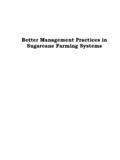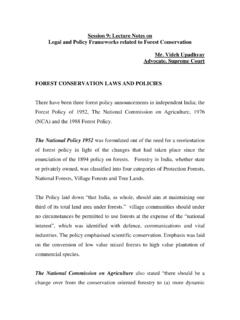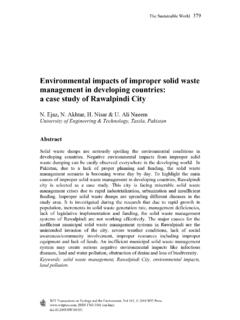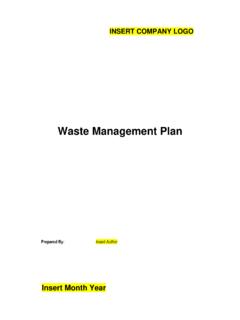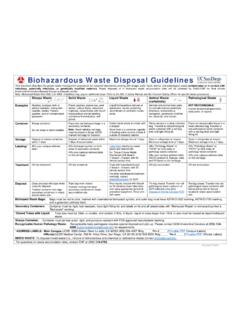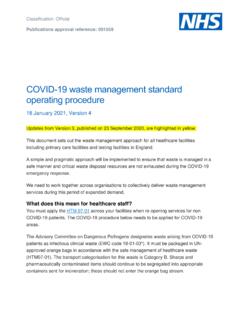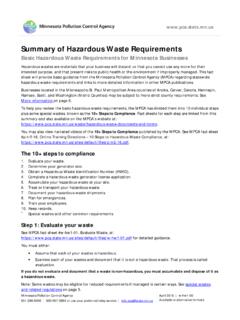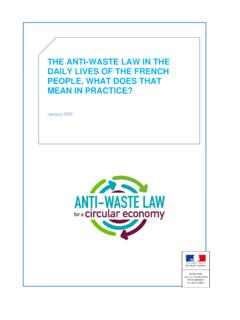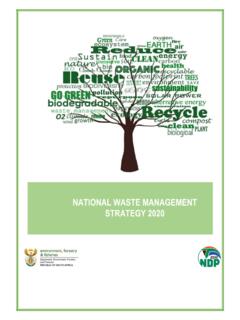Transcription of HAZARDOUS WASTE MANAGEMENT IN INDIA
1 HAZARDOUS WASTE MANAGEMENT IN INDIA Babu1# and V. Ramakrishna2 Birla Institute of Technology & Science Pilani 333 031 (Rajasthan) INDIA ABSTRACT Disasters occur due to both the natural and man-made activities. Hazards and Disasters are categorized into four groups, viz., Natural events, Technological events, Man-made events and Region-wise events. The adverse impacts caused due to the indiscriminate disposal of HAZARDOUS Wastes (HWs) come under the category of Environmental Disasters. HAZARDOUS WASTE MANAGEMENT (HWM) is a very important issue and is assuming significance globally. There is no proper secured landfill facility available in INDIA to dispose of HAZARDOUS WASTE (HW) till 1997. Very few industries in INDIA , mostly in large scale and a few in medium scale, own proper treatment and disposal facilities.
2 A common WASTE treatment and disposal facility such as Treatment, Storage and Disposal Facility (TSDF) for MANAGEMENT of HWs generated from industries, is one of the useful options under such conditions. Few Guidelines issued by Ministry of Environment and Forests under HAZARDOUS Wastes ( MANAGEMENT & Handling) Rules, 1989 promulgated under Environment (Protection) Act, 1986 are available in INDIA for selection of best site for TSDF. The planning for HWM comprises of several aspects ranging from identification and quantification of HW to development and monitoring of TSDF. This paper focuses on the basic steps involved in the Comprehensive HWM. The physical models developed by the authors for ranking of TSDF sites based on the Guidelines available are discussed. The current status in INDIA pertaining to generation of HW and the TSDF sites is also addressed.
3 INTRODUCTION Disasters occur due to both the natural and man-made activities (Khare, 2001). A hazard is a rare or extreme event that adversely impacts human life, property, or activity. No human settlements are free from the risk of natural hazards; therefore it is vital that researchers and decision-makers have access to all available hazards information (NGDC, 2003). E&DM (2003) classified the Hazards and Disasters into four categories viz., Natural events, Technological events, Man-made events and Region-wise events (Refer Table-1). The adverse impacts caused due to the indiscriminate disposal of HAZARDOUS Wastes (HWs) come under the category of Environmental Disasters. For example, in 1982, 2242 residents are evacuated after dioxin is found in soil in Missouri, In 1996-97, 265354 tonnes of soil and other dioxin-contaminated material from Times Beach (Missouri, ) and 26 other sites in eastern Missouri had been incinerated (E&DM, 2003).
4 Release of Methyl Isocyanate (MIC) gas in Bhopal (1984) caused a severe disaster in INDIA (Banerjee, 2001; E&DM, 2003). Table-1: Types of Hazards and Disasters Types of Hazards & Disasters Events 1 Natural Events Avalanches, Cyclones, Droughts, Dust/Sand storms, Earth Quakes, Epidemic Diseases, Famines, Floods, Heat waves, Hurricanes, Landslides/Mud slides, Lightening storms, Tornadoes, Typhoons, Volcanic eruptions, Wild-land fires. 2 Technological Events Environmental Disasters, Fire and Explosion, Accidents (Industrial, Nuclear, Radiological, Transportation), Dam failures. 3 Man-made Events Bio-Terrorism, Spreading Chemical Agents, Mass Hysteria, Sabotage, Assassinations, Vandalism etc. 4 Region-wise Events Events specific to a region such as INDIA . 1 Assistant Dean ESD & Head of Chemical Engineering & Engineering Technology Departments; # Corresponding Author; Ph: +91-1596-245073 Ext.
5 205 / 224; Fax: +91-1596-244183 E-mail: Home Page: ; 2 Lecturer, Civil Engineering Group; E-mail: There is a growing concern all over the world for the safe disposal of HWs generated from anthropogenic sources. HWs can be classified (Babu and Gupta, 1997) into- (i) Solid wastes (ii) Liquid wastes (iii) Gaseous wastes (iv) Sludge wastes. HPC (2001) defines HW as any substance, whether in solid, liquid or gaseous form, which has no foreseeable use and which by reasons of any physical, chemical, reactive, toxic, flammable, explosive, corrosive, radioactive or infectious characteristics causes danger or is likely to cause danger to health or environment, whether alone or when in contact with other wastes or environment, and should be considered as such when generated, handled, stored, transported, treated and disposed off.
6 This definition includes any product that releases HAZARDOUS substance at the end of its life, if indiscriminately disposed off. The HW needs to be disposed off in a secured manner in view of their characteristic properties. Severe pollution of land, surface and ground water may occur (Ramakrishna and Babu, 1999a; Rao, 1999) if the options available (Wentz, 1995; Parsa et al., 1996; Chakradhar et al., 1999) for HAZARDOUS WASTE MANAGEMENT (HWM) are not being efficiently utilized by the WASTE generators. As per the ideal industrial siting criteria in INDIA , the industry should have enough land available within its premises for the treatment and disposal and or reuse/recycling of the wastes generated from it (Murali Krishna, 1995). However, very few industries in INDIA own proper treatment and disposal facilities (Jeevan Rao, 1999).
7 Mostly the large-scale industries and a few medium-scale industries (Ramakrishna and Babu, 1998), and none of the small-scale industries own the above facilities. Among the 1440 industries identified (as on ) in the country with a high potential for pollution, 203 industries ( , ~14%) are recorded as not having adequate facilities to comply with the regulatory standards for treatment and disposal of wastes (TEDDY, 1998). Financial, administrative, and infrastructural facilities are some of the reasons attributed for the above limitations. It is interesting to note that, till 1997, there is no secured landfill facility available in the country to dispose of HW (HPC, 2001). HAZARDOUS Wastes (HWs) are disposed off at Treatment, Storage and Disposal Facility (TSDF), a centralized location catering to the HW generated from the WASTE generators in the near vicinity.
8 The TSDF will help the small and medium scale industries generating HW in disposing their wastes efficiently. Literature is available on the site selection and other related criteria of TSDF (Ramakrishna and Babu, 1999b; Lakshmi, 1999; Babu and Ramakrishna, 2000; Babu and Ramakrishna, 2003). The site selection criteria for a TSDF depend upon Receptors and Pathways of likely WASTE movement, WASTE characteristics and WASTE MANAGEMENT practices (Guidelines, 1991). The planning for HWM comprises of several aspects ranging from identification and quantification of HW to development and monitoring of TSDF. This paper focuses on the basic steps involved in the Comprehensive HWM (CHWM). The physical models developed by the authors (Babu and Ramakrishna, 2000; Babu and Ramakrishna, 2003) for ranking of TSDF sites based on the Guidelines available (Lakshmi, 1999; Guidelines, 1991) are also discussed.
9 The current status in INDIA pertaining to generation of HW and the TSDF sites is also addressed. BASIC APPROACH IN HAZARDOUS WASTE MANAGEMENT The Government of INDIA has promulgated the HAZARDOUS WASTE ( MANAGEMENT & Handling) Rules [HW (M&H)] in 1989 through the Ministry of Environment and Forests (MOEF) under the aegis of Environment (Protection) Act [E(P) Act], 1986. Under the HW (M&H) Rules, the HAZARDOUS wastes are divided into 18 categories. The details (HPC, 2001) are given in Table-2. Moreover, the role and responsibilities of the WASTE generator, state/central pollution controls boards and state Government is clearly defined. In order to encourage the effective implementation of these rules, the MOEF has further brought out the Guidelines for HW (M & H) Rules in 1991 (Maudgal, 1995; Ramakrishna and Babu, 1999b) giving the technical details of the principles of HWM covered under the HW (M&H) Rules, 1989.
10 However, the selection of a suitable site for an effective functioning of TSDF is the key aspect and depends upon several factors such as WASTE characteristics, site characteristics, public acceptance and prevailing laws & regulations. The facility siting should also incorporate the protection of human health, environment and property values in a community. Though the selection of an ideal site confirming with the above factors is a difficult task, few Guidelines are available (Guidelines, 1991) in INDIA for selection of best site for the same purpose. In INDIA , unauthorized dumping of HWs is however continuing and in most of the places, the HW is being utilized to fill the low-lying areas (HPC, 2001), which is not acceptable. Table-2: Categories of HAZARDOUS Wastes WASTE Category WASTE Type Regulatory Quantities 1 Cyanide wastes 1 kg per year as cyanide 2 Metal finishing wastes 10 kg per year the sum of the specified substance calculated as pure metal 3 WASTE containing water soluble chemical compounds of lead, copper, zinc, chromium, nickel, selenium, barium and antimony 10 kg per year the sum of the specified substance calculated as pure metal 4 Mercury, arsenic, thallium, and cadmium bearing wastes 5 kg per year the sum of the specified substance calculated as pure metal 5 Non-halogenated hydrocarbons including solvents 200 kg per year calculated as non-halogenated hydrocarbons 6 Halogenated hydrocarbons including solvents 50 kg per year calculated as halogenated hydrocarbons 7 Wastes from paints, pigments, glue, varnish.
